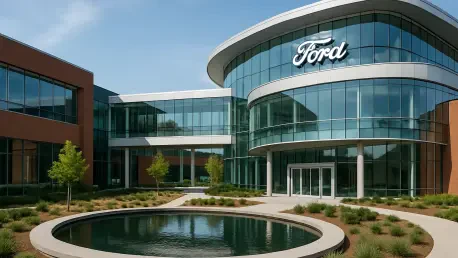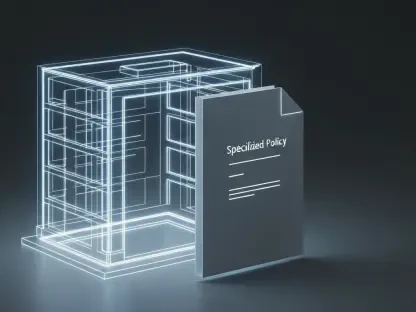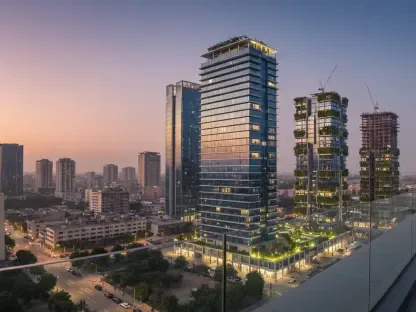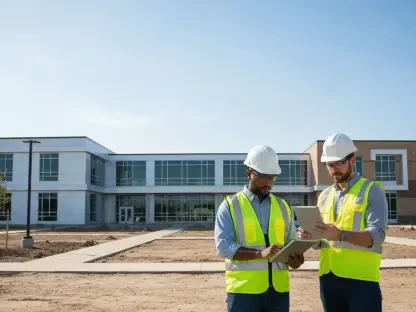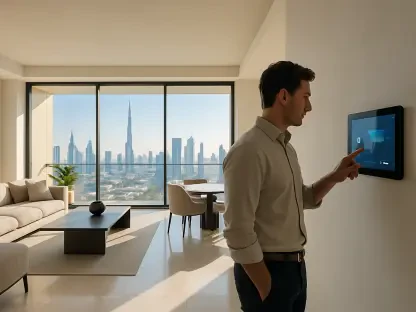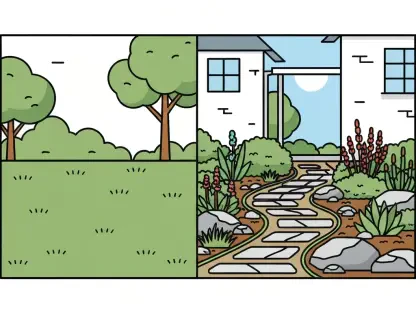Ford Motor Company’s bold decision to relocate its world headquarters from the historic “Glass House” in Dearborn, Michigan, to a cutting-edge innovation hub nearby has sparked significant interest across the automotive and business sectors, marking a pivotal moment for the iconic automaker. Announced on September 15, this transition represents a monumental shift for an automaker that has been rooted at the Glass House since 1956. Far from a mere change of address, the move to a sprawling 2.1-million-square-foot facility near the Henry Ford Museum signals Ford’s intent to redefine its operational ethos and competitive edge in a fast-evolving industry. This strategic pivot is not just about modernizing infrastructure but about reshaping how the company innovates, collaborates, and attracts talent in an era increasingly driven by technology and sustainability.
The new headquarters, crafted by the globally acclaimed architectural firm Snøhetta, embodies a vision of workplace transformation. It promises to unite executives and product development teams under one roof for the first time in decades, breaking down barriers that have long hindered real-time collaboration. With state-of-the-art amenities and a design focused on employee well-being, Ford is positioning itself to rival tech giants in the race for skilled professionals. This relocation also marks the end of an era for the Glass House, a mid-20th-century icon, as plans for its sustainable demolition by late 2027 or mid-2028 loom on the horizon. The emotional and historical weight of this transition is palpable, yet Ford’s leadership is resolute in embracing a future-focused mindset.
The Drive for Modernization
Innovation at the Core
Ford’s new headquarters is engineered to ignite innovation by physically uniting key teams in a way the Glass House never facilitated. Spanning over 300 tech-enabled meeting rooms and incorporating vertical integration for swift material movement, the facility is a deliberate tool to enhance real-time interaction. This setup directly addresses the inefficiencies of the past, where physical separation between departments often slowed decision-making. Leadership views this co-location as critical, particularly as the automotive industry accelerates toward electric and autonomous vehicle development. The design ensures that ideas can flow seamlessly from concept to execution, positioning Ford to maintain agility in a highly competitive landscape.
Beyond the logistical advantages, the innovation hub is a statement of Ford’s ambition to lead rather than follow industry trends. The sprawling campus, located just a mile west of the Glass House at Oakwood Boulevard and Village Road, is equipped to handle comprehensive product reviews in a single space with six design studios and a large showroom. This capability eliminates the fragmented workflows that plagued operations at the older site. By fostering an environment where engineers, designers, and executives can interact spontaneously, Ford aims to shorten development cycles and bring cutting-edge solutions to market faster. This strategic focus on proximity and technology underscores a broader commitment to staying ahead in an era of rapid transformation.
Redefining Workplace Culture
The new campus goes beyond operational upgrades to signal a profound cultural shift within Ford. Features like unassigned desks, diverse seating arrangements, and expansive outdoor workspaces cater to a modern, hybrid workforce that values flexibility. This design prompts speculation about whether Ford might eventually mandate a full five-day onsite workweek, though no definitive plans have been confirmed. The emphasis on creating a “third space”—a comfortable, inspiring environment—reflects an understanding that today’s employees prioritize workplace quality alongside traditional incentives. This shift is a deliberate move to align with contemporary expectations and foster a sense of community among staff.
Employee well-being is at the heart of this cultural redefinition, evident in amenities like wellness rooms, mothers’ rooms, and a 160,000-square-foot food hall curated by an executive chef. These elements are not mere luxuries but strategic investments to boost morale and productivity. By offering spaces that encourage relaxation and informal collaboration, Ford seeks to create an atmosphere where creativity thrives. The contrast with the rigid, hierarchical layout of the Glass House could not be starker, as the new hub prioritizes openness and adaptability. This approach is intended to resonate with younger, tech-oriented professionals who are accustomed to dynamic environments, ensuring Ford remains an attractive employer in a talent-driven market.
Honoring History While Embracing Change
Saying Goodbye to the Glass House
Leaving the Glass House is not merely a physical relocation but a deeply emotional milestone for Ford. As the company’s sixth headquarters in its 122-year history, the building has been a repository of memories, from triumphant product launches to grueling strategy sessions during economic downturns like the Great Recession. Executive Chair Bill Ford has openly shared mixed feelings about departing a space where he spent nearly five decades. Yet, with its outdated design rooted in an era of private offices and isolated workflows, the consensus among leadership is that its relevance has faded. The planned sustainable demolition by late 2027 or mid-2028 marks a poignant end, but one approached with respect for its legacy.
The Glass House, constructed between 1953 and 1956, was once a beacon of modernity with innovative features like tinted windows to manage heat and glare. However, its International Style architecture, emblematic of mid-20th-century corporate ideals, no longer aligns with the collaborative needs of today’s business environment. Leadership acknowledges that clinging to such outdated infrastructure could impede progress in an industry demanding agility. The decision to preserve the Henry Ford II World Center name and maintain the iconic address of 1 American Road at the new site reflects a careful balance of honoring history while stepping boldly into the future. This transition is a testament to Ford’s ability to evolve without erasing its storied past.
A New Chapter in Dearborn
The new innovation hub integrates Ford’s rich heritage into its modern framework through thoughtful design touches, such as art crafted from vehicle parts and patent numbers embedded in the façade. These elements serve as subtle nods to the company’s legacy while establishing a forward-looking identity. Retaining the symbolic address of 1 American Road ensures a thread of continuity, even as the physical landscape transforms. This blend of old and new positions Ford as an employer that respects its roots while embracing the demands of a tech-driven era, appealing to both long-standing employees and fresh talent.
Ford’s approach to this monumental shift is methodical, with a phased transition already underway. Starting with 500 employees on-site, the plan is to scale up to 4,000 by 2027, ensuring minimal disruption during the move. This gradual process reflects a commitment to maintaining operational stability while adapting to the new environment. The location near the Henry Ford Museum further ties the hub to Dearborn’s historical significance, reinforcing Ford’s deep connection to the community. As the company builds this new chapter, the focus remains on creating a space that not only drives innovation but also embodies the enduring spirit of an American industrial giant, ready to tackle future challenges with renewed vigor.
Competing for Talent and Sustainability
Attracting the Best Minds
In a fiercely competitive market for talent, Ford’s new headquarters is a strategic weapon designed to lure the brightest minds, particularly those with tech expertise. Employee-centric features such as mothers’ rooms, wellness spaces, and a meticulously curated food hall offering seven dining options are far more than perks—they are calculated moves to rival the appeal of Silicon Valley tech hubs. Executive Chair Bill Ford has cited inspiration from Apple’s campus, emphasizing that a stunning and functional workplace is non-negotiable in attracting the next generation of innovators. This focus is critical as Ford pivots toward technology-intensive areas like electric and autonomous vehicles, where skilled professionals are in high demand.
The design of the campus also caters to modern workforce expectations by prioritizing flexibility and inspiration over traditional office rigidity. Outdoor courtyards and diverse workspaces encourage a balance between productivity and personal well-being, aligning with what today’s employees value most. This isn’t just about filling positions but about building a community of forward-thinkers who can propel Ford’s ambitions. By creating an environment that competes with the best in the industry, the company signals its readiness to invest in people as much as in products. This approach is a clear recognition that in the current landscape, talent attraction can be as decisive as technological advancement in determining long-term success.
A Commitment to Green Design
Sustainability stands as a cornerstone of the new headquarters, reflecting Ford’s alignment with broader industry trends toward environmental responsibility. Designed as a Net-Zero Energy Building, the facility operates on 100% renewable electricity sourced from an on-campus Central Energy Plant. Additionally, an ambitious target ensures that 95% of disposable items are compostable, recyclable, or reusable, minimizing waste. These features are not just compliance measures but a proactive stance on reducing environmental impact, positioning Ford as a leader in sustainable corporate practices within the automotive sector.
This green focus extends beyond energy and waste to influence the very ethos of the campus design. The integration of natural light, outdoor spaces, and eco-friendly materials creates a workspace that feels connected to its surroundings, fostering a sense of responsibility among employees. Such initiatives resonate with a growing demographic of professionals who prioritize working for companies with strong environmental values. Ford’s commitment to sustainability also serves as a competitive differentiator, appealing to stakeholders and customers who increasingly demand corporate accountability. By embedding these principles into the heart of its new hub, Ford demonstrates that progress and planetary stewardship can go hand in hand, setting a benchmark for others in the industry to follow.
Reflecting on a Historic Shift
Ford Motor Company’s relocation from the storied Glass House to a visionary innovation hub in Dearborn encapsulates a defining moment of reinvention. This transition, executed with a nod to history through the preservation of symbolic names and addresses, honors the past while decisively embracing modern demands. The sustainable demolition of the Glass House by late 2027 or mid-2028, coupled with plans to repurpose its land for community benefit, showcases a thoughtful approach to closure. Meanwhile, the new 2.1-million-square-foot campus stands as a testament to Ford’s resolve to lead in collaboration, efficiency, and environmental stewardship.
Looking ahead, the next steps involve not only completing the phased move of thousands of employees by 2027 but also leveraging this new environment to drive breakthroughs in automotive technology. Ford must continue to refine its workplace policies to balance flexibility with productivity, ensuring the hub’s design translates into tangible innovation. Collaborating with Dearborn officials to transform the Glass House site into a public asset could further cement Ford’s role as a community pillar. This historic shift, guided by bold leadership through years of industry turbulence, offers a blueprint for other corporations: embracing change, when rooted in strategic vision and cultural sensitivity, can pave the way for enduring relevance and impact.
